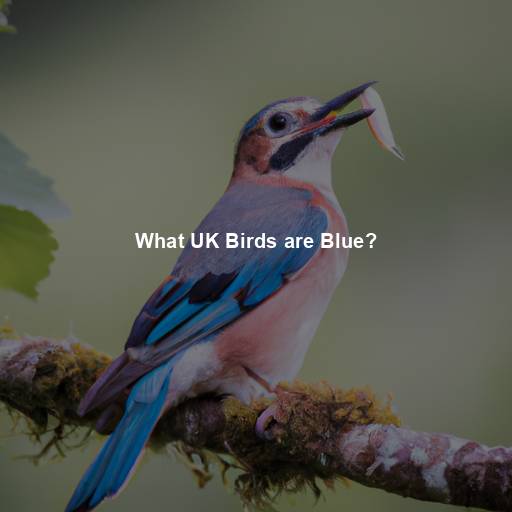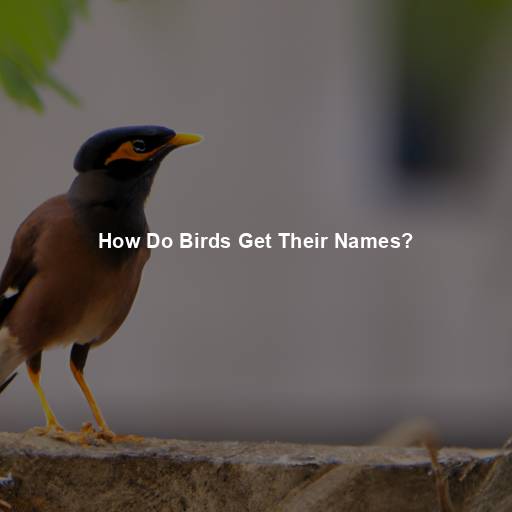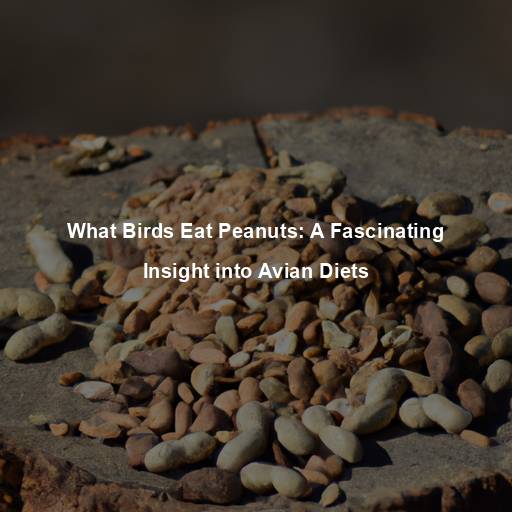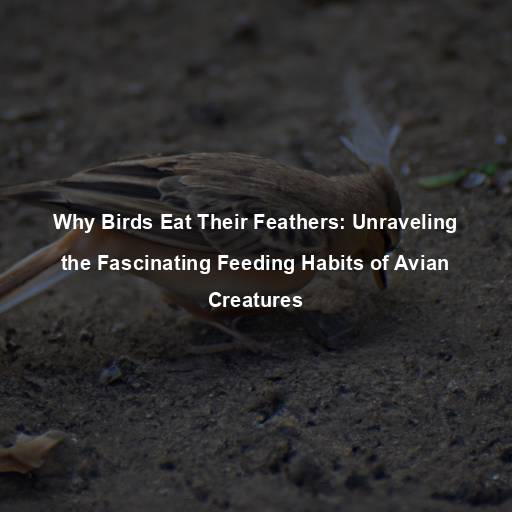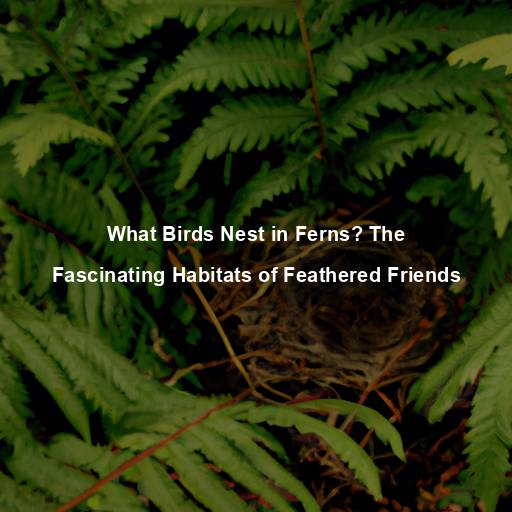Which Birds are Dinosaurs: Exploring the Intriguing Connection
Last Updated on October 28, 2023 by Evan
Contents [hide]
- 1
- 2 The Avian Evolutionary Tree
- 3 The Feathered Evidence
- 4 The Bone Connection
- 5 Genetic Clues: Unlocking the Past
- 6 The Impact of Avian Dinosaurs
- 7 Unraveling the Mystery: Ongoing Research
- 8 The Fascinating Journey Continues
- 9 FAQs – Which Birds are Dinosaurs
- 9.1 What is the connection between birds and dinosaurs?
- 9.2 Are all birds considered dinosaurs?
- 9.3 How do scientists know that birds are descendants of dinosaurs?
- 9.4 When did birds evolve from dinosaurs?
- 9.5 Are all dinosaurs considered birds?
- 9.6 Do all birds today resemble dinosaurs?
- 9.7 Can you provide examples of bird species that are considered dinosaurs?
Birds have always captivated our imagination with their graceful flight, vibrant plumage, and melodic songs. But did you know that birds are more than just beautiful creatures? They hold a fascinating secret, a connection to the prehistoric era that ignites our curiosity and challenges our understanding of evolution. In this article, we will delve into the captivating world of avian dinosaurs, exploring the scientific evidence that supports their evolutionary link.
The Avian Evolutionary Tree
Unlocking the mysterious bond between our winged friends and their prehistoric counterparts requires us to navigate the labyrinthine path of avian evolution. The emergence of the modern avian community, dubbed Neornithes, dates back to a staggering 66 million years ago, following the catastrophic event that sealed the fate of non-avian dinosaurs. Yet, their ancestral roots reach back even further into the annals of time, intertwining with the enigmatic theropod clan of dinosaurs. Journey with us as we tread upon the beguiling footsteps of these ancient creatures and unravel the web that connects the birds of today to their dinosaurian ancestors.
Theropods: The Ancestors of Birds
Imagine a world where fearsome creatures roamed the earth, their diversity unmatched during the ancient Mesozoic Era. Among these enigmatic beings were the mighty theropods, known for their carnivorous appetite and razor-sharp instincts. From the awe-inspiring Tyrannosaurus rex to the nimble Velociraptor, these predators ruled the prehistoric domain. However, it was the revelation of feathered fossils that shook the foundation of our understanding, unveiling an unexpected connection between these formidable beasts and their distant avian descendants.
Archaeopteryx: The Missing Link
Archaeopteryx, a small dinosaur resembling a bird, serves as a crucial piece in the puzzle of avian evolution. Discovered in the late 19th century, this ancient creature possessed both reptilian and avian characteristics. With feathered wings and sharp teeth, Archaeopteryx epitomized the transitional form between reptiles and birds.
The Feathered Evidence
Feathers are the defining feature that binds birds and dinosaurs together. These remarkable structures not only enable flight but also provide valuable insights into the shared ancestry of these creatures.
The Origins of Feathers
Feathers, those enchanting wonders of the natural world, hold secrets untold. In the captivating realm of evolution, their story weaves a tapestry of perplexity and awe. Once believed to have sprouted as mere insulation or to woo a potential mate, these ancient adornments transformed with time. As if dancing with destiny, they gradually evolved into the magnificent flight feathers that grace our avian companions today.
Feathered Dinosaurs: A Spectacular Discovery
In recent years, the discovery of numerous feathered dinosaur fossils has astounded the scientific community. From the Velociraptor of “Jurassic Park” fame to the Yutyrannus, a tyrannosaur with feathers, these findings provide compelling evidence for the dinosaur-bird connection. The intricate preservation of feathers in these fossils leaves little room for doubt about the existence of feathered dinosaurs.
The Bone Connection
While feathers have played a crucial role in establishing the link between birds and dinosaurs, there are other skeletal features that reinforce this connection. Through the study of dinosaur and bird skeletons, paleontologists have identified striking similarities that highlight their shared evolutionary history.
Hollow Bones: A Structural Advantage
An intriguing similarity between birds and their prehistoric dinosaur predecessors lies in their fascinating possession of hollow bones. This captivating adaptation, known to lighten the skeletal load, paves the way for the awe-inspiring phenomenon of flight in the avian world. Astonishingly, this feature also emerges in certain theropod dinosaurs, hinting at a captivating connection stretching back through the annals of time.
The Wishbone: A Telltale Trait
The captivating link between birds and dinosaurs is further illustrated by a fascinating skeletal characteristic, known as the furcula or wishbone. This peculiar V-shaped bone plays a vital role in avian flight, offering a remarkable blend of stability and support. Surprisingly, this captivating feature is not exclusive to birds but has also been unearthed in select non-avian dinosaurs, leaving scientists perplexed yet amazed by the convergence of these ancient creatures.
Genetic Clues: Unlocking the Past
In addition to the physical evidence provided by feathers and bones, modern genetic research has shed light on the evolutionary connection between birds and dinosaurs. By analyzing the DNA of living bird species, scientists have uncovered fascinating insights into their ancient lineage.
The “Dino-Bird” Genes
Recent genetic research has unveiled an awe-inspiring revelation about our feathered friends: birds possess a series of extraordinary genetic sequences, colloquially known as the mysterious “dino-bird genes”. These genes, responsible for the mesmerizing evolution of feathers and other distinctive avian traits, hold a captivating resemblance to their prehistoric counterparts found within the formidable dinosaurs. The very existence of these remarkable genetic remnants serves as yet another compelling testament to the captivating notion that birds are the living descendants of their mighty dinosaur ancestors, inviting us to ponder the intriguing connections that intertwine through the intricate tapestry of evolution.
The Impact of Avian Dinosaurs
The fascinating intertwinement of birds and dinosaurs goes beyond a mere intellectual pursuit. Delving into this enigmatic bond holds vast implications for unraveling the depths of evolution and deciphering the intricate fabric of the natural world that envelops us.
Rewriting the Textbooks
In a groundbreaking revelation, scientists have unearthed the remarkable presence of feathered dinosaurs, rewriting the very fabric of our understanding of evolutionary history. This astonishing connection between birds and their prehistoric ancestors has cast a perplexing shadow over the established paradigms, leaving experts in a state of unanticipated awe. The textbooks of the future are poised to undergo a staggering transformation, weaving a captivating narrative that unravels the intricacies of the ancient world and its profound influence on the vibrant tapestry of life as we know it today.
Conservation and Preservation
Recognizing birds as living dinosaurs fosters a greater appreciation for their conservation and preservation. By understanding their ancient lineage and the pivotal role they play in our ecosystems, we can work towards ensuring their survival for future generations.
Inspiring Scientific Curiosity
The connection between birds and dinosaurs captures the imagination of both young and old, inspiring scientific curiosity and igniting a passion for discovery. By unraveling the mysteries of our avian friends, we encourage a deeper understanding of the natural world and the wonders it holds.
Feathered Dinosaur or Flightless Bird?
In the vast realm of paleontology, a captivating debate unfurls around the classification of certain dinosaurs. These enigmatic beings straddle the nebulous line between being labeled “feathered dinosaurs” or “flightless birds”. Adorned with feathers but lacking the vital adaptations for airborne maneuvers, they leave scientists in a state of perpetual intrigue. The classification conundrum continues to captivate paleontologists, who engage in passionate discussions to untangle the perplexing identity of these ancient creatures.
The Origin of Flight
The allure of avian flight has captivated the scientific community, leaving them pondering the enigmatic origins of this aerial prowess. Feathers adorning dinosaur species offer tantalizing glimpses into the potential for flight, yet the intricate path that led to the birth of powered flight remains shrouded in an aura of intrigue. With an unyielding dedication, researchers navigate through the convoluted maze of unanswered questions, tirelessly piecing together fragments to complete the formidable puzzle of evolutionary flight.
Wing-Assisted Incline Running (WAIR)
The fascinating debate around the genesis of flight leads us to a riveting hypothesis: perhaps our avian friends trace their lineage back to dinosaurs who harnessed their feathered forelimbs for unconventional purposes. Dubbed the captivating “Wing-Assisted Incline Running” theory, this notion suggests that the initial spark of flight emerged from ancient climbers scaling tilted terrains using their newfound feathers. By intertwining climbing behaviors with the passage of time, powered flight may have gradually taken flight in the evolutionary history of these graceful creatures.
Arboreal Gliders
New speculations on the intriguing world of dinosaurs have surfaced, proposing the idea that some ancient creatures may have been adept at gliding between trees. It is hypothesized that these remarkable beings, with their feathered limbs, could have utilized their natural abilities to gracefully maneuver through the dense foliage. This theory presents the possibility that the evolution of powered flight might have been a gradual progression, with gliding acting as a perplexing intermediate phase in the mesmerizing journey of ancient creatures.
The Limits of Fossil Evidence
While fossils provide invaluable insights into the ancient world, they have their limitations. The fossil record is not complete, and many species may have left behind no trace of their existence. This makes it challenging to reconstruct the evolutionary history of birds and dinosaurs with absolute certainty. However, ongoing discoveries and advancements in paleontological techniques continue to expand our knowledge.
Unraveling the Mystery: Ongoing Research
In a world embroiled with debates and obstacles, the relentless pursuit of scientists to untangle the enigmatic bond between dinosaurs and birds remains unwavering. The ever-evolving landscape of research across diverse disciplines has begun to illuminate the labyrinthine depths of this enthralling subject matter.
Advanced Imaging Techniques
In the vibrant world of scientific discovery, imaging techniques have taken a quantum leap forward. Pioneering methods like computed tomography (CT) scans and synchrotron radiation imaging have unlocked a mesmerizing window into the past. Now, the long-hidden secrets of fossils are emerging, like elusive treasures, with unimaginable clarity. These groundbreaking techniques unravel the enigmatic tapestry of life, revealing delicate soft tissues and elaborate feather patterns, unraveled by time.
Comparative Genomics
By comparing the genomes of birds and reptiles, researchers have uncovered genetic similarities and differences that offer insights into their shared ancestry. Comparative genomics is a powerful tool for tracing the evolutionary history of birds and dinosaurs and understanding the genetic mechanisms that led to their divergence.
Experimental Paleontology
Step into the captivating world of experimental paleontology, where researchers blend the enigmatic study of fossils with cutting-edge experimental techniques to unravel the mysteries of ancient life. Through ingenious experiments involving living birds and reptiles, scientists embark on a voyage back in time to illuminate the extraordinary behaviors and remarkable capabilities of their dinosaur predecessors. This groundbreaking interdisciplinary field offers a mesmerizing glimpse into the enthralling evolution of birds, as they emerge from the fossilized embrace of their dinosaur ancestry.
Paleoenvironmental Reconstruction
Understanding the environments in which dinosaurs and early birds lived is crucial for reconstructing their evolutionary history. Paleoenvironmental reconstruction involves analyzing fossilized plants, insects, and other organisms found alongside dinosaur and bird fossils. By piecing together the ecological puzzle, scientists can gain a better understanding of the conditions that shaped the evolution of birds from dinosaurs.
The Fascinating Journey Continues
As scientists delve deeper into the intricate web that ties together birds and dinosaurs, a world of unexpected revelations awaits. With each new stride in research, the enigmatic tale of avian dinosaurs unfolds, leaving us captivated by the ongoing saga of exploration and enlightenment. As the puzzle pieces gradually come together, the allure of the unknown and the promise of uncharted territories beckon us to follow this riveting scientific expedition. The intertwined paths of birds and dinosaurs, shrouded in ancient mysteries and endless possibilities, beckon us to embark on an exhilarating and perplexing journey of discovery.
When we begin to see birds as modern-day descendants of dinosaurs, it opens up our minds to the fascinating web of life that exists on our planet. We come face to face with the intriguing notion that the lines between the past and present can blur, reminding us that history is not a distant memory but rather an integral part of our present reality. In this unique perspective, dinosaurs continue their remarkable journey alongside us, gracefully gliding through the heavens, blessing our world with an array of vibrant hues, enchanting melodies, and an endless sense of awe.
As we cross paths with a fragile bird, let us be entranced by its untold story of survival. A creature so ancient, it has traversed the eons, defying the very concept of oblivion. Take a breath, let bewilderment wash over you, and unravel the intricate threads of existence that tie us to these mesmerizing beings that grace our world.
As we continue to explore the depths of our natural world, let us approach it with curiosity, open minds, and a sense of wonder. For it is through this spirit of inquiry and discovery that we uncover the most extraordinary truths, rewriting the narratives that shape our understanding of the past, present, and future.
Step into a world where the captivating connection between birds and their ancient dinosaur ancestors takes flight, leaving us awestruck and filled with a sense of wonder. Immerse yourself in an extraordinary voyage of discovery, as we celebrate the remarkable legacy that these feathered beings have preserved throughout the ages. Prepare to be captivated by the limitless realms of exploration that lie ahead, where the mysteries of our avian friends continue to perplex and amaze. Welcome to a realm where the boundaries of awe are shattered, and the wonder of our flying companions is exalted beyond measure.
FAQs – Which Birds are Dinosaurs
What is the connection between birds and dinosaurs?
Did you know that birds, those graceful creatures soaring through our skies, are actually the descendants of fierce dinosaurs? It’s a mind-boggling revelation that these feathered friends trace their heritage back to a group of stealthy hunters known as theropods. With their hollow bones, nimble three-toed limbs, and a taste for prey, these dinosaurs laid the groundwork for the evolution of our avian companions. Thanks to the meticulous study of their skeletal features, scientists have unraveled the fascinating connection between birds and their mighty dinosaur ancestors. So, next time you spot a bird, take a moment to appreciate the awe-inspiring journey it undertook to become the marvelous creature it is today.
Are all birds considered dinosaurs?
Did you know that birds are actually classified as dinosaurs? It’s true! Scientifically speaking, there’s ample evidence to support this fascinating notion. These feathered creatures share many distinctive features with their ancient ancestors, such as the presence of feathers, a wishbone, and their ability to lay eggs. It’s incredible to think that despite their modern appearance, birds and dinosaurs are more closely connected than we could have ever imagined.
How do scientists know that birds are descendants of dinosaurs?
In the vast realm of scientific exploration, a remarkable revelation has emerged, challenging our preconceived notions of the natural world. Through meticulous analysis of ancient skeletal remains, a profound connection between dinosaurs and birds has been unveiled. Millions of years of history have left behind a trail of compelling evidence, showcasing striking similarities in the anatomical blueprint of these seemingly distant creatures. Departing from traditional assumptions, the investigation delves deeper into the enigmatic realm of feathers and intermediate features, amplifying the legitimacy of this evolutionary bond. Notably, recent advances in genetic studies have further illuminated the common heritage shared by these extraordinary beings.
When did birds evolve from dinosaurs?
There’s a fascinating scientific enigma that has experts scratching their heads and debating fervently – the elusive timeline of when majestic birds took flight from their dinosaur origins. While the exact period remains tantalizingly uncertain, the general consensus among these perplexed scholars centers around the notion that roughly 150 million years ago, during the late Jurassic Period, the intricate dance of bird evolution began. Remarkably, the fossilized remnants of a mesmerizing creature named Archaeopteryx have captivated experts, providing a glimpse into the enigmatic transition from dinosaur to our avian friends. Over an expanse of countless eons, this bewildering evolutionary journey eventually unveiled the diverse array of captivating bird species that grace our present-day skies.
Are all dinosaurs considered birds?
Believe it or not, the dino world is far more diverse than we may think, and not every dino can rock the label of “bird.” Sure, birds are part of the theropod dinosaur gang, but let’s not forget the other cool cats roaming around. From the towering herbivores like Brachiosaurus to the fierce meat-eaters like T. rex, dinosaurs showcase a wild range of species. So, while birds proudly flaunt their dino heritage, they’re just one branch of the fascinating dino family tree.
Do all birds today resemble dinosaurs?
Birds, the feathered creatures of the sky, hold a mesmerizing secret – they are the direct descendants of dinosaurs. Yet, these avian marvels have undergone a magnificent metamorphosis over eons, carving their own evolutionary path. This journey has led to a kaleidoscope of bird species, each boasting their unique characteristics and adaptations. While traces of their dinosaurian ancestry remain, birds have embarked on a captivating odyssey of transformation, leaving behind remnants from the age of dinosaurs.
Can you provide examples of bird species that are considered dinosaurs?
When it comes to the fascinating world of avian creatures, there exists a perplexing and extraordinary connection to their prehistoric ancestors. Unbeknownst to many, several bird species are part of the esteemed dinosaur lineage. These captivating avian dinosaurs leave us in awe with their burst of diversity, showcasing the intricate tapestry of evolution that has unfolded over millions of years. Let us embark on a journey to explore these enigmatic feathered creatures, delving into the surprising ties that bind them to their ancient heritage.
Unleashing its intellect and agility, the Velociraptor, once present but now merely a fragment of history, danced between the realms of reptiles and birds, captivating audiences with its mesmerizing presence in the iconic “Jurassic Park” movies. As if emerging from a time-traveling portal, this diminutive yet awe-inspiring creature showcased its prominence in the intricate web of life’s evolution.
In the deep recesses of Earth’s history, a stunning creature once roamed the ancient landscapes, bewildering scientists with its perplexing blend of avian elegance and reptilian ferocity. Known as Archaeopteryx, this ancient marvel embodied the enigmatic bridge between dinosaurs and birds, defying the boundaries of time and evolution. Its magnificent plumage, reminiscent of today’s winged creatures, danced in the wind, while the glint of sharp teeth whispered intriguing tales of its prehistoric lineage. Though now lost to the annals of extinction, Archaeopteryx continues to captivate our imaginations, forever etched in the annals of evolutionary mystique.
-
Cassowary – These flightless birds native to Australia and New Guinea exhibit certain anatomical similarities to their dinosaur ancestors. With their fierce appearance and striking colors, cassowaries are a remarkable example of modern dinosaurs.
-
Ostrich – The largest living bird species, ostriches possess long legs, small wings, and feathers reminiscent of their dinosaur predecessors. They are excellent runners and exhibit various dinosaurian traits.
When we talk about birds and dinosaurs, it’s not just a select few feathered friends that fall under this category. No, no, my friends, it encompasses all the avian creatures that grace our skies today. We’re talking about a fascinating connection that stretches across time and evolution, leaving us in awe and wonder at the perplexing complexities of the natural world. Take a moment to let that burst of knowledge sink in, and marvel at the fact that our feathery friends are the descendants of the mighty dinosaurs that once roamed the Earth. Isn’t nature just mind-boggling?


